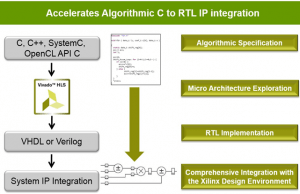High-Level Synthesis with the Vitis HLS Tool
✅ Indicates CONFIRMED TO RUN
Course Description
This course provides a thorough introduction to the Vitis™ High-Level Synthesis (HLS) tool. The focus is on:
- Converting C/C++ designs into RTL implementations
- Learning the Vitis HLS tool flow
- Creating I/O interfaces for designs by using the Vitis HLS tool
- Applying different optimization techniques
- Improving throughput, area, latency, and logic by using different HLS pragmas/directives
- Exporting IP that can be used with the Vivado® IP catalog
- Downloading for in–circuit validation
Level
DSP 3
Course Duration
2 days
Audience
Software and hardware engineers looking to utilize high-level synthesis
Prerequisites
- C, C++, or System C knowledge
- High-level synthesis for software engineers OR high-level synthesis for hardware engineers
Software Tools
- Vitis HLS tool 2022.2
- Vivado Design Suite 2022.2
- Vitis unified software platform 2022.2
Hardware
- Architecture: Zynq® UltraScale+™ MPSoC and Versal® AI Core series*
- Demo board: ZynqUltraScale+ MPSoC ZCU104 board*
* This course focuses on the Zynq UltraScale+ MPSoC architecture. Check with your local Authorized Training Provider for the specifics of the in-class lab board or other customizations
Skills Gained
After completing this comprehensive training, you will know how to:
- Enhance productivity by using the Vivado HLS tool
- Describe the high-level synthesis flow
- Use the Vivado tool HLS for a first project
- Identify the importance of the testbench
- Use directives to improve performance and area and select RTL interfaces
- Identify common coding pitfalls as well as methods for improving code for RTL/hardware
- Perform system-level integration of IP generated by the Vivado HLS tool
Course Outline
Day 1
- Introduction to High-Level Synthesis – Overview of the High-level Synthesis (HLS), Vitis HLS tool flow, and the verification advantage. {Lecture}
- Vitis HLS Tool Flow – Explore the basics of high-level synthesis and the Vitis HLS tool. {Lecture, Demo, Lab}
- Abstract Parallel Programming Model for HLS – Describes the structuring of a design at a high level using anabstract parallel programming model. {Lecture}
- Design Exploration with Directives – Explore different optimization techniques that can improve the design performance. {Lecture}
- Vivado HLS Tool Command Line Interface – Describes the Vitis HLS tool flow in command prompt mode. {Lecture, Lab}
- Introduction to HLS UltraFast Design Methodology – Introduces the methodology guidelines covered in this course and the HLS UltraFast Design Methodology steps. {Lecture}
- Introduction to I/O Interfaces – Explains interfaces such as block-level and port-level protocols abstracted by the Vitis HLS tool from the C design. {Lecture}
- Block-Level I/O Protocols – Explains the different types of block-level protocols abstracted by the Vitis HLS tool. {Lecture, Lab}
- Port-Level I/O Protocols – Describes the port-level interface protocols abstracted by the Vitis HLS tool from the C design. {Lecture, Demo, Lab}
- AXI4 Adapter Interface Protocols – Explains the different AXI interfaces (such as AXI4-Master, AXI4-Lite (Slave), and AXI4-Stream) supported by the Vitis HLS tool. {Lecture, Demo}
- Port-Level I/O Protocols: Memory Interfaces – Describes the memory interface port-level protocols (such as block RAM, FIFO) abstracted by the Vitis HLS tool from the C design. {Lecture, Lab}
- Pipeline for Performance: PIPELINE – Describes the PIPELINE directive for improving the throughput of a design. {Lecture, Lab}
Day 2
- Pipeline for Performance: DATAFLOW – Describes the DATAFLOW directive for improving the throughput of a design by pipelining the functions to execute as soon as possible. {Lecture, Lab}
- Optimizing for Throughput – Identify the performance limitations caused by arrays in your design. You will also explore optimization techniques to handle arrays for improving performance. {Lecture, Demo, Lab}
- Optimizing for Latency: Default Behavior – Describes the default behavior of the Vitis HLS tool on latency and throughput. {Lecture}
- Optimizing for Latency: Reducing Latency – Describes how to optimize the C design to improve latency. {Lecture}
- Optimizing for Area and Logic – Describes different methods for improving resource utilization and explains how some of the directives have impact on the area utilization. {Lecture, Lab}
- Migrating to the Vitis HLS Tool – Reviews key considerations when moving from the Vivado HLS tool to the Vitis HLS tool. {Lecture}
- HLS Design Flow – System Integration – Describes the traditional RTL flow versus the Vitis HLS design flow. {Lecture, Lab}
- Vivado HLS Tool C++ Libraries: Arbitrary Precision – Describes the Vivado HLS tool support for the C/C++ languages, as well as arbitrary precision data types. {Lecture, Lab}
- Hardware Modeling – Explains hardware modeling with streaming data types and shift register implementation using the ap_shift_reg class. {Lecture}
- Using Pointers in the Vivado HLS Tool – Explains the use of pointers in the design and workarounds for some of the limitations. {Lecture}

Date
10 May 2023 - 11 May 2023
Location
Core|Vision
Cereslaan 24
5384 VT
Heesch
Price
€ 0,00
or
20 Xilinx Training Credits
Information
Training brochure
Registration form
Registration on demand, please contact us.
